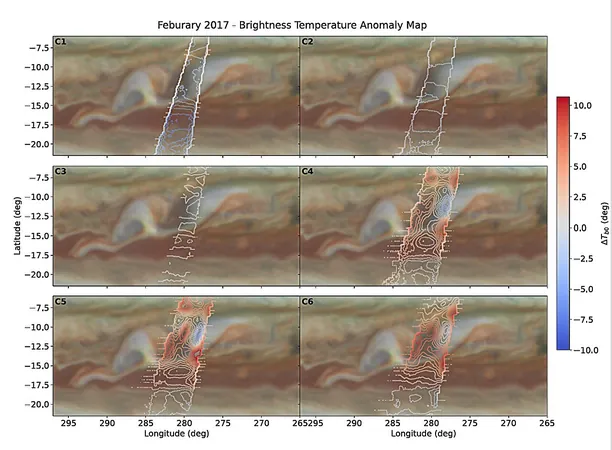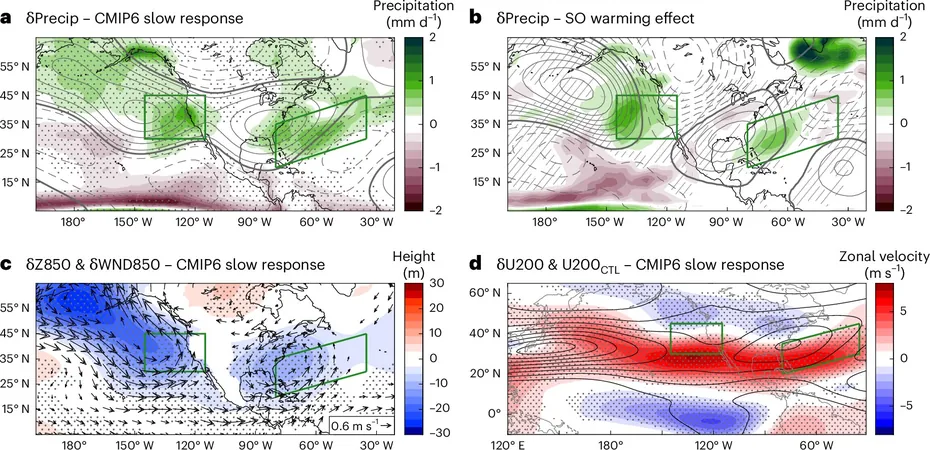
Unveiling Jupiter's Turbulent Secrets: How a Colossal Storm Disperses Ammonia into the Depths of the Atmosphere
2025-04-04
Author: Siti
A significant scientific breakthrough has emerged from research conducted by a group of planetary scientists at the University of California, in collaboration with experts from the California Institute of Technology. Their findings, detailed in the prestigious journal *Science Advances*, reveal a fascinating process where a colossal storm on Jupiter, which commenced in 2016, channeled vast amounts of ammonia throughout the gas giant's thick atmosphere.
As advancements in space observation technology have skyrocketed over the last few decades, astronomers have gathered a wealth of information about the storms that plague our neighboring planets, particularly Jupiter. These products of nature are not merely spectacular; they significantly influence atmospheric dynamics and conditions.
The study centers around a major storm that ravaged Jupiter from 2016 to 2017. In this research, scientists utilized data from an array of sensational sources including the Atacama Large Millimeter/submillimeter Array in Chile, the iconic Hubble Space Telescope, and NASA's Juno space probe, which fortuitously captured the planet during this turbulent time.
By meticulously comparing data from these advanced observational tools, the researchers tracked the erratic flow of ammonia as it was displaced by intense downdrafts, allowing it to plunge from the upper reaches of Jupiter’s atmosphere to depths rarely explored. Intriguingly, even long after the storm subsided, these atmospheric movements left a lasting "fingerprint," indicating substantial amounts of ammonia gas sequestered in lower atmospheric layers.
In an innovative leap, the research team developed a simulation that portrayed the storm's atmospheric components dynamically, emphasizing the behavior of ammonia. The simulation illustrated how ammonia gas was forced deep beneath the clouds, later lifted through vigorous updrafts, leading to a phenomenon described as the “drying out” of the atmosphere.
As these ammonia and water mixtures descended, they formed dark, slushy formations resembling "hail" on Earth. This slush eventually returned to the lower layers of the atmosphere during subsequent downdrafts, persisting in a cycle of precipitation and evaporation.
Ultimately, the scientists concluded that even after the storm's remnants faded, pockets of ammonia continued to linger in the five-layered atmosphere of Jupiter, revealing the complex interplay of storm dynamics on this massive gas giant. This research not only deepens our understanding of Jupiter’s meteorological patterns but also paves the way for future explorations into the atmospheric behaviors of other celestial bodies, unlocking mysteries of our solar system one storm at a time.
Stay tuned for more groundbreaking discoveries as scientists continue to unravel the enigmatic nature of Jupiter and beyond!



 Brasil (PT)
Brasil (PT)
 Canada (EN)
Canada (EN)
 Chile (ES)
Chile (ES)
 Česko (CS)
Česko (CS)
 대한민국 (KO)
대한민국 (KO)
 España (ES)
España (ES)
 France (FR)
France (FR)
 Hong Kong (EN)
Hong Kong (EN)
 Italia (IT)
Italia (IT)
 日本 (JA)
日本 (JA)
 Magyarország (HU)
Magyarország (HU)
 Norge (NO)
Norge (NO)
 Polska (PL)
Polska (PL)
 Schweiz (DE)
Schweiz (DE)
 Singapore (EN)
Singapore (EN)
 Sverige (SV)
Sverige (SV)
 Suomi (FI)
Suomi (FI)
 Türkiye (TR)
Türkiye (TR)
 الإمارات العربية المتحدة (AR)
الإمارات العربية المتحدة (AR)